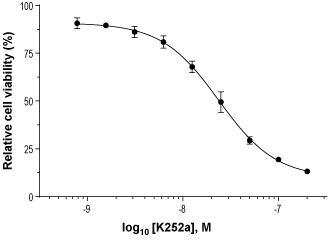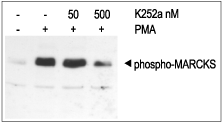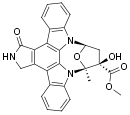Overview
Cat #:
K-150
Alternative Name SF 2370
Lyophilized Powder yes
Origin Nocardiopsis sp. (soil fungi).
Source Natural
MW: 467.5
Purity: >98%
Effective concentration 10-200 nM.
Chemical name 9,12-Epoxy-1H-diindolo(1,2,3-fg:3',2',1'-kl)pyrrolo(3,4-i)(1,6)benzodiazocine-10-carboxylic acid, 2,3,9,10,11,12-hexahydro-10-hydroxy-9-methyl-1-oxo-, methyl ester, (9alpha,10beta,12alpha)-.
Molecular formula C27H21N3O5.
CAS No.: 97161-97-2
Activity K252a inhibits a variety of kinases including PKC (IC50 = 25 nM), PKA (IC50 = 18 nM) and PKG (IC50 = 20 nM)1. It also inhibits CaMK (IC50 = 1.8 nM) and MLCK (IC50 = 17 nM). K252a has also been shown to inhibit NGF mediated proliferation through the Trk receptor family2.
References-Activity
- Kase, H. et al. (1987) Biochem. Biophys. Res. Commun. 142, 436.
- Tapley, P. et al. (1992) Oncogene 7, 371.
Shipping and storage Shipped at room temperature. Product as supplied can be stored intact at room temperature for several weeks. For longer periods, it should be stored at -20°C.
Solubility DMSO. Centrifuge all product preparations before use (10000 x g 5 min).
Storage of solutions Up to one week at 4°C or three months at -20°C.
Protect from light.
Protect from light.
Our bioassay
 Alomone Labs K252a inhibits NGF-mediated survival of serum-deprived PC12 cells.Dose-response curve of K252a (#K-150) inhibition of the 100 ng/ml Native mouse NGF 2.5S protein (>95%) (#N-100) mediated survival of serum-deprived PC12 cells. IC50 was determined at 23.7 nM.
Alomone Labs K252a inhibits NGF-mediated survival of serum-deprived PC12 cells.Dose-response curve of K252a (#K-150) inhibition of the 100 ng/ml Native mouse NGF 2.5S protein (>95%) (#N-100) mediated survival of serum-deprived PC12 cells. IC50 was determined at 23.7 nM. Alomne Labs K252a inhibits MARCKS phosphorylation via PKC in C6 glioma cells.Cells were grown to 70% confluence, and then serum starved for 18 h. The cells were preincubated for 30 min with different concentrations of K252a (#K-150) and stimulated with 2 µM PMA (#P-800) for 30 min. Cell proteins were resolved by SDS-PAGE and probed with anti-phospho (ser)-MARCKS (myristoylated alanin-rich protein kinase C substrate).
Alomne Labs K252a inhibits MARCKS phosphorylation via PKC in C6 glioma cells.Cells were grown to 70% confluence, and then serum starved for 18 h. The cells were preincubated for 30 min with different concentrations of K252a (#K-150) and stimulated with 2 µM PMA (#P-800) for 30 min. Cell proteins were resolved by SDS-PAGE and probed with anti-phospho (ser)-MARCKS (myristoylated alanin-rich protein kinase C substrate). Alomone Labs K252a inhibits tyrosine phosphorylation of TrkA in PC12 cells.Cells were incubated in the presence or absence of 10 ng/ml NGF with or without various concentrations of K252a (#K-150). The inhibitory effect of K252a on neurite outgrowth stimulated by NGF is presented.
Alomone Labs K252a inhibits tyrosine phosphorylation of TrkA in PC12 cells.Cells were incubated in the presence or absence of 10 ng/ml NGF with or without various concentrations of K252a (#K-150). The inhibitory effect of K252a on neurite outgrowth stimulated by NGF is presented.
References - Scientific background
- Ruegg, U.T. and Burgess G.M. (1989) Trends Pharmacol. Sci. 10, 218.
- Elliott, L.H. et al. (1990) Biochem. Biophys. Res. Commun. 171, 148.
- Simpson, D.l. et al. (1991) J. Neurosci. Res. 28, 148.
- Chin, L.S. et al. (1999) Cancer Invest. 17, 391.
- Tapley, P. et al. (1992) Oncogene 7, 371.
- Hashimoto, S. (1998) J. Cell Biol. 107, 1531.
- Kase, H. et al. (1987) Biochem. Biophys. Res. Commun. 142, 436.
- Hirayama E. et al. (2001) Biochem. Biophys. Res. Commun. 285, 1237.
- Borasio, G.D. (1990) Neurosci. Lett. 108, 207.
- Hashimoto, S. and Hagino A. (1989) Exp. Cell Res. 184, 351.
- Tischler, A.S. et al. (1991) J. Biol. Chem. 266, 1141.
Scientific background
K252a is an alkaloid isolated from Nocardiopisis sp. soil fungi. This ATP analogue is a highly potent cell permeable inhibitor of CaM kinase and phosphorylase kinase (IC50= 1.8 and 1.7 nM respectively). At higher concentrations it is also an efficient inhibitor of serine/threonine protein kinases (IC50 of 10 to 30 nM).1-8
It is reported to promote myogenic differentiation in C2 mouse myoblasts5 and has been shown to block the neuronal differentiation of rat pheochromocytoma PC12 cells by inhibition of trk tyrosine kinase activity.9 Paradoxically K252a exerts neurotrophic effects on primary sensory neurons, neuroblastoma cells, PC12 cells, and central neurons.10,11
Target Protein kinases
Lyophilized Powder
K252a (#K-150) is a highly pure, natural, and biologically active compound.
For research purposes only, not for human use
Last Update: 07/05/2024
Applications
Citations
Citations
Product citations
- Jiang, B. et al. (2016) Int. J. Neuropsychopharmacol. In press.
- Mu, R.H. et al. (2016) Psychopharmacology 233, 3211.
- Trubiani, O. et al. (2016) Cell. Signal. 28, 1631.
- Igelhorst, B.A. et al. (2015) Philos. Trans. R. Soc. Lond. B. Biol. Sci. 370, 1.
- Jiang, B. et al. (2015) Int. J. Neuropsychopharmacol. 18, 1.
- Jiang, B. et al. (2014) Int. J. Neuropsychopharmacol. 18, 1.
- Fujita, Y. et al. (2013) Cell Death Dis. 4, e763.
- Kondo, Y. et al. (2013) J. Neurochem. 124, 224.
- Odate, S. et al. (2013) Lung Cancer 79, 205.
- Ovejero-Benito, M.C. and Frade, J.M. (2013) PLoS ONE 5, e64890.
- Ramos-Languren, L.E. and Escobar, M.L. (2013) Eur. J. Neurosci. 37, 1248.
- Meis, S. et al. (2012) J. Physiol. 590, 193.
- Tomokiyo, A. et al. (2012) J. Cell. Physiol. 227, 2040.
- Jiang, B. et al. (2012) Br. J. Pharmacol. 166, 1872.
- Akil, H. et al. (2011) PLoS ONE 6, e25097.
- Bellanger, C. et al. (2011) PLoS ONE 6, e27213.
- Fujita, Y. et al. (2011) EMBO J. 30, 1389.

